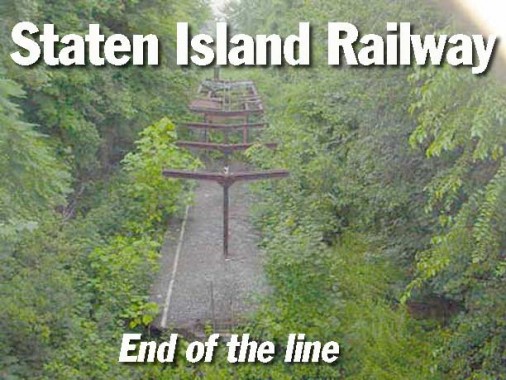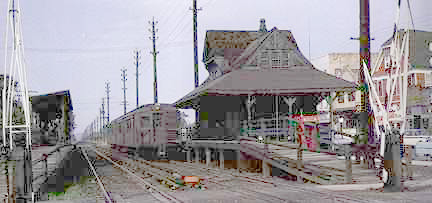Still thriving between St. George and Tottenville, the Staten Island Railway, a subway in everything but name that extends from St. George Ferry to Tottenville, was once much more extensive. On this page we’ll show you traces of the SIRT as it once was.
A short history:
Non-residents of Staten Island may not know that the borough has its very own rail line which, although resembling a subway, isn’t run as a subway at all. Formerly known as Staten Island Rapid Transit, the Staten Island Railway was begun by Cornelius Vanderbilt in 1851 for the purposes of linking Vanderbilt’s Landing in Stapleton to Clifton. By 1860, the line was extended to Eltingville, then on to Annadale, and finally to Tottenville.
In 1883, Erastus Wiman, in partnership with the Baltimore & Ohio Railroad, built a line to South Beach and along the North Shore. By 1885, what would become the SIRT was complete, with the completion of the tunnel between Stapleton and the St. George Ferry. The ferry terminal opened in 1897 (the present-day terminal was constructed in 2005 after a fire destroyed the 1946 terminal, which in turn replaced the original, also destroyed by a blaze).
By 1953, ridership had dropped to such a degree (due to reduced bus fares) that the B&O threatened to terminate all passenger service. The City agreed to subsidize service on the Tottenville line and terminate service on the North Shore and South Beach branches. The B&O ended its involvement with Staten Island Rapid Transit in 1971, selling it to NYC for $3.5 million. Quaint B&O passenger coaches that had operated on the line since 1925 were replaced by modern R-44 subway cars. Finally, the MTA changed the name of the SIRT in 1994, renaming it the Staten Island Railway.
This is a former Staten Island Rapid Transit car, No. 388, which ran in the SIRT until the year 1971.
It is currently residing in retirement at the Shoreline Trolley Museum in East Haven, CT.
In the 1970s, the Richmondtown Restoration (at Richmond and Arthur Kill Roads) bought the old New Dorp station house and restored it. (The canopies on the outside of the station were removed.) It stands on Court Place today. The second photo shows it in place just before the grade cross was eliminated.
Some stationhouses dating to the 1930s are still found in many stations along the line.
This map shows Staten Island Rapid Transit at its fullest extent, before the closures of the South Beach and North Shore branches in 1953. Today only the branch from the ferry to Tottenville remains. Note the spur tracks on the southern end — we will mention those later. On the left, the tracks to Travis were strictly freight and are still in use.
South Beach Branch
The South Beach Branch of the SIRT exists today only as a ghost branch. After service was stopped in 1953, the right-of-way remained in place for many years. Housing construction has begun on the remains of the old railroad.
The South Beach spur separated from the main line just south of Clifton and ran on a right-of-way through the Rosebank, Clifton and Arrochar neighborhoods that in many cases trundled on either side of private homes. The line terminated at Wentworth Avenue in South Beach, at a platform so short it was only a DOOR length!
While the North Shore branch has remained relatively intact, developers have been resolute in destroying nearly all traces of what was the South Beach Branch.
Arrochar station on the South Beach branch, photographed in the 1940s. This station was shuttered in 1953; the approach ramps for the Verrazano Bridge now stand in its place. Photo courtesy Anthony Paonita. The name “Arrochar” comes from the estate of W.W. MacFarland of the clan MacFarland in the 1840s, [who developed the area and named it for] his home village of Arrochar in Scotland. wikipedia
In 1999, a clear sign of the old SIRT could still be seen at McClean and Railroad Avenues, where there was still a bridge over the old railroad cut. The north side of the bridge is still intact here, but at the south side the cut has been filled in and the Pebble Lane Houses are being built there now. A very short portion of the old fence is still there. The fences have since vanished.
Railroad Avenue, sans railroad
Railroad Avenue featured an actual railroad running alongside it between 1936 and 1953. All trace of its namesake has vanished, as new housing has sprung up on the former South Beach SIRT right of way.
Robin Road Bridge
This old bridge, which is over Robin Road near Austin Avenue in the Arrochar section, is a rusting reminder that the South Beach Branch carried commuters between St George and Wentworth Avenue until 1953. It’s now one of the final remnants of the South Shore Branch, which is now being rapidly filled in by developers.
Embankment, just west of Robin Road on Austin Avenue, carried SIRT trains. The tresle shown above is just off the right edge of the picture. This scene is now filled with tract housing.
1936
The presence of old SIRT stanchions on now-residential streets makes for some interesting juxtapositions. The SIRT formerly had a railroad bridge over St. Johns Avenue in Rosebank, just west of Wingham Street. After service was eliminated in 1953, the trestles were removed gradually, but some do remain, and some of the stanchions that supported them are still there. This section of St. Johns Avenue features a lot of new construction, but new residents may be confused about the large structure with the date 1936 carved into it. 1936 was the date this branch of the SIRT was elevated, removing the grade crossings.
This was a rusting iron stanchion and a concrete wall that carried the SIRT over Willow Avenue and Langere Place in Clifton. The SIRT alternately ran at grade and on concrete and iron overpasses in Clifton. Note the “Bridge No. 4” sign. Trains ran for only 17 years here, between 1936 and 1953.
As of 2012 this, too, had been torn down.
Virginia Avenue
In a heartbreaking scene for railfans, the rubble of an SIRT overpass lies on Virginia Avenue and Tilson Place, waiting to be carted away. What’s going up in its place? Houses that all look the same.
Tompkins Avenue
The Tompkins Avenue bridge, just south of Fingerboard Road, spans the old South Shore Branch RR cut. Photos: Gary Owen
North Shore Branch
Until the Staten Island Ferry Terminal was completely rehabilitated in 2005, the railroad station still employed these old-style track indicators. The indicator with the green light was the one where you boarded the train. After 1953, only the indicator reading TOTTENVILLE was supposed to be used, but, occasionally, a mistake was made and the indicator was set to ARLINGTON, like this one.
Between St. George and West Brighton the SIRT tracks are close to the Kill van Kull and the waves have taken their toll, with smashed up ties and bent rails. Photos: Joe Resse
Snug Harbor
Also opposite Snug Harbor are these mysterious tablets facing Kill Van Kull. Since the SIRT had a Sung Harbor station, it’s possible these tablets were a part of the station, or were meant for passing boats. These partially-buried tracks can be found above Richmond Terrace opposite the Snug Harbor Cultural Center. Above 4 photos: Christina Wilkinson
On an expedition just south of Snug Harbor in the spring of 2011 the founder of the Newtown Pentacle and I found the tracks in good condition in some spots, but completely washed out in others.
The Port Richmond station was located between the tracks on the trestle above and behind the old public restroom on Church Street and Park Avenue. photos: Doug Douglass
The Bayonne Bridge looms behind the Tower Hill station on Grove and Sharpe Avenues. The station took its name from the mansion belonging to the widow of pencil manufacturer Eberhard Faber, now the site of Faber Park and Pool. There is also a Faber Avenue in Port Richmond.
Photos: Doug Douglass
Bottom: Arlington on the last day of service, 1953. NYCSubway.org
Arlington carries on as a freight yard, with the Arthur Kill lift bridge providing a connection to New Jersey.
In the Travis yards southwest of the North Shore Branch between Victory Boulevard and Meredith Avenue, we had a genuine relic until recently…
This 1925 vintage SIRT car was running on the SIRT when it was still part of the Baltimore and Ohio Railroad.
According to my sources, it belongs to the Trolley Museum of New York in Kingston, though the train car is in such decrepit condition that it apparently can’t be moved.
In November 2003, the car was moved to a separate location, and then disappeared, and we fear the worst.
Car photos: Marc Pitanza
More photos of this ghost can be found at
http://ltvsquad.com/Missions/Other/SIRTCar/Damned.php
Staten Island Railway Station that Looks Closed, But Isn’t:
In the early 1990s, The MTA renovated many Staten Island Rapid Transit stations, and gave the line a new name, Staten Island Railway.
However, the MTA planned on closing a couple of stations on the western end of the route and opening a new station on Arthur Kill Road in Tottenville. This plan never came to fruition, and the stations that were going to be closed, Nassau and Atlantic, have been left to deteriorate and decay. One or two cars open their doors at these very short platforms.
This is the Nassau station platform, which dates to the mid-to-late 1970s and hasn’t been touched since. The railing is likely much older. The platform edges are wooden, and dig the old stencil platform sign (which have been removed since this was shot in 1999). Above we see the stairway leading to the overpass on the Nassau station. The roof is caving in and the concrete steps are chipping and treacherous.
Unusual Sighting
Unusual sighting on the Tottenville Branch, Amboy Road and Luten Avenue, February 2005: as trackwork was being done, a work train consisting of several cabooses (cabeese?) was moving up and down the tracks.
Vintage Steam Staten Island
A Baltimore & Ohio Staten Island steamer pulls into Eltingville sometime in the 1920s.
Did you know that the SIRT once had a spur to the Mount Loretto children’s home in Pleasant Plains, near the end of the line in Tottenville? The spur accommodated steam engines and wasn’t electrified like the rest of the line. Although the service ended by mid-century, the tracks were in place until the 1980s and the spur’s junction with the SIRT was recently removed. Above is a rare picture of one of the steam engines used on the line courtesy of Paul Matus.
Thanks to Forgotten Fans Jeff Barr, Gary Owen, Joe Resse, Doug Douglass and FNY CorrespondentChristina Wilkinson for assistance with this page
Written 7/20/99; updated 2009, 2012



